Prime
Energy crisis: Inside South Africa’s limping economy

South Africa's main opposition party Democratic Alliance (DA) party members chant during their march to the Union Buildings in Pretoria on March 29, 2018. The march aims at protesting against energy giant Eskom and the looming electricity tariff hike of over 9.4 per cent.
What you need to know:
- Now a combination of factors, not least the persistent outages of the national power-producer Eskom, have pushed many marginal operations into permanent stoppage.
- Nigeria is now the continent’s largest economy, with S. Africa falling to second place just ahead of Egypt.
- S. Africa, per current estimates, contributed just 41.7 per cent of Africa’s total output in 2022, down by over 11 per cent in just over half a decade.
It is a truism to say that South Africa’s modern industrialised economy was built off the back of mining.
It is also true to say that mining, as an economic backbone of the country’s development, has long since ebbed away to be a shadow of its former self.
But it is still important as a major sector in the economy, and it is one of those sectors feeling the harsh bite of successive administrations’ failure to ensure reliable, affordable energy.
And now a combination of factors, not least the persistent outages of the national power-producer Eskom, have pushed many marginal operations into permanent stoppage, reduced the importance of this sector enormously and forced other industry players to produce their own power.
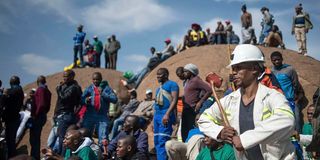
Miners gather during commemorations to mark the fourth anniversary of the Marikana Massacre in Rustenburg on August 16, 2016. On August 16, 2012, workers at the Lonmin-owned Marikana mine northwest of Johannesburg were observing a wildcat strike to demand the minimum wage.
Mining was estimated to have contributed $12.5 billion (R211 billion) directly to the sovereign wealth of $1.25 trillion in 2022, or just 1 per cent, though its ancillary industry and downstream value chain may be worth as much as eight times that figure.
Given the historic role of mining in building the industrialised S. African economy from the late 1800s when diamonds and then gold were discovered, S. Africa’s mining industry is near an all-time low, in relative terms.
Effectively, the ‘New York of Africa’, Johannesburg, was built off the back of mainly gold mining, with palladium-group metals, especially platinum, acting as an important contributor, along with coal, during S. Africa’s initial century of industrialisation and manufacturing sector development.
Mining's contribution to total economic production climbed in the 1970s to peak at 21 per cent in 1980, with a relatively high gold price adding to the upward value surge at that time.
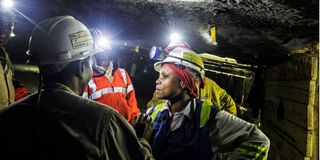
33-year-old miner Bernice Motsieloa (R) briefs miners on their daily duties at the Anglo-American Bathopele Mine in Runstenburg, North Western Province of South Africa, some 170 km from Johannesburg, on June 11, 2015.
But that was then, with things going not nearly so well for mining in S. Africa since.
Mining production in S. Africa, in fact, averaged -0.08 per cent between 1981 and 2022, reaching an all-time high of 119.6 per cent in April 2021, and a record low of 50.6 per cent in April 2020, a direct consequence of the Covid-19 pandemic reflected in that dramatic decline.
Mining decline
Anti-apartheid unionisation and associated industrial and political action, along with a growing anti-apartheid sanctions regime internationally, saw mining’s relative role in the economy decline steadily through the 1980s, a negative trend that continues today.
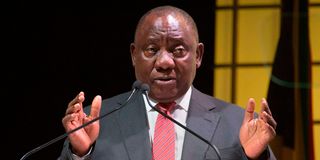
South African President Cyril Ramaphosa.
Manufacturing and beneficiation of locally-extracted raw commodities, such as steel production, historically grew in line with mining — these two ‘conjoined economic twins’ routinely locked in step — and has likewise also shrunk.
Reflecting mining’s diminishing role in the increasingly services-based economy, manufacturing, which had been the largest single sector in 1980, fell to fourth place by 2016 and is now worth just $32 billion (R545.5 billion), just 2.56 per cent of total GDP in 2022.
Nigeria is now the continent’s largest economy, with S. Africa falling to second place just ahead of Egypt.
The pattern of S. Africa’s proportional decline in contributions to the continent’s total wealth output is directly in line with the decline in its mining productivity, as compared with the rest of the economy.
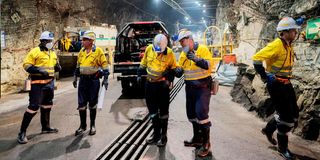
Managers of Gold Fields South Africa walk in an operative area in the South Deep gold mine in Westonaria, Gauteng, on October 12, 2022.
S. Africa's contribution to the continent's GDP in 2017 was $156.3 billion, 53 per cent of total African output in that year.
As of 2022, the GDP in Africa was estimated at roughly $3 trillion ($3,000b), the highest value since 2010 when the continent's GDP amounted to about $2 trillion (adjusted for average estimated inflation, based on 2015 values).
This means that in real terms, S. Africa’s relative contribution to continental output has fallen in the last six years dramatically, as other sub-Saharan African economies have — despite Covid-19 and other challenges — surged ahead.
S. Africa, per current estimates, contributed just 41.7 per cent of Africa’s total output in 2022, down by over 11 per cent in just over half a decade.
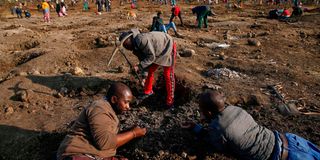
A man uses a pick axe to dig as others search for what they believe to be diamonds after the discovery of unidentified stones at KwaHlathi village near Ladysmith, South Africa, on June 15, 2021.
It is this radical decline that has been among the many issues occupying the mind of President Cyril Ramaphosa and which he spoke to at a mining conference last week where he underlined the importance of this crumbling sector to S. Africa’s good financial health.
But the mining sector, which at the recent conference was mainly concerned with the government’s inability to provide it with reliable, cost-effective power, has largely given up on waiting to be bailed out of its power crisis by the Ramaphosa administration and has aggressively committed to co-generational energy production.
Multi-hour outages
The latter step, born of necessity with multi-hour outages now a daily occurrence and set to endure for “at least two to three years”, according to Eskom officials, may eventually help ordinary S. Africans out of their power crisis crunch by alleviating the call for power from 24-hour deep underground mining operations using their own power supplies, and perhaps with some excess to feed into the national grid.

In this file photo taken on February 16, 2022, A woman uses a rechargeable LED lantern to illuminate a shoe rack while shopping at the Sinnoville Centre after its electricity supply was cut off by the City of Tshwane (COT) municipality for allegedly having a bill of 16 Million South African Rands, in Pretoria.
But that win-win outcome is still a way off, with most major and minor mining operations working at full speed to fill in the power shortages being generally experienced.
Also a potential positive is that many of the mining houses now intent upon full replacement of Eskom’s unreliable electricity provision, some operating the deepest mines in the world at over 3kms underground, are also providing their own power with ‘green’ renewables like wind and solar, with battery array backups, among other solutions.
For S. Africa, a leader per capita producer of greenhouse gas emissions due to its over 80 per cent reliance on coal-burning power station output, this too is eventually likely to become ‘good news’, in that reducing mining’s call on electricity will mean the country can wean itself off of polluting coal power production sooner than later.
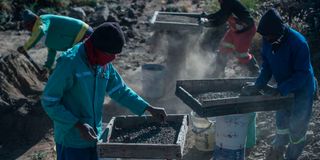
Independent miners filter dirt and soil as they search for minerals following the legalisation of mining in limited areas on June 5, 2018, in Kimberley, Northern Cape, South Africa.
The S. African mining sector said through industry channels recently that it aims to reduce its consumption from the national power grid by as much as 30 per cent by creating some 73 self-generation or co-generation projects.
Energy being one of the biggest expenses for mining companies, at about 30 per cent of operating costs, the move away from Eskom is seen as one of the quickest ‘fixes’ to S. Africa’s persistent and likely long-lasting power deficiencies.
Renewable energy sources
The move to renewable energy sources is viewed by industry experts as not merely a ‘cost’, but a strategic effort that ought to reduce costs, or at least stabilise them, improve safety, reliability and sustainability, and mitigate risks.
The Minerals Council of South Africa said ‘rolling blackouts’, as imposed by power-constrained Eskom, had damaged mining infrastructure, resulting in the loss of many millions of dollars in earnings and constituted an ongoing threat to the security and safety of some 2,000 miners who go deep underground daily.
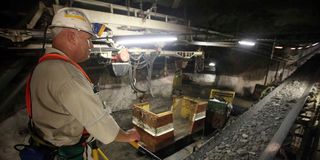
A shaft manager monitors production on January 19, 2011, in 14 Shaft of the Impala Platinum mine in Phokeng, the capital of the Bafokeng kingdom, about 120 kilometres (75 miles) northwest of Johannesburg.
With the country running routinely at some 6,000MW short of peak demand – despite theoretically having nearly double the installed capacity compared to demand – mines without their own power supply are, like the rest of the country, enduring up to 18 hours of powerlessness every three-day cycle.
The industry employs nearly 460,000 people and adds 8.4 per cent to GDP, when downstream value chains are included, but has been heavily hit by the ongoing outages, says the Minerals Council, both in terms of lost production and lost investment.
“South Africa experienced more power supply disruptions in 2022. This led to a decline in mineral production across all commodities. It is estimated that load shedding costs the economy about ($59 million) a day,” said Minerals and Mining Minister Gwede Mantashe last week, apparently referring narrowly to the cost of repeat outages to the mining and related sectors only.

A man holds a sign saying that Eskom, the South African electricity public utility, is not for sale during a demonstration by members of the Congress of South African Trade Unions (COSATU) on February 13, 2019 in Johannesburg, South Africa.
The full costs of the outages are hard to evaluate but are thought by economists to amount to at least double the minister’s figure when lost investment and other economic opportunities are factored in.
To counter the problem of power, the council says mining operations, both small and big, will add 5,100MW of renewable energy, due to come online in the next few years.
This energy will come from a mix of wind and solar and will enable Eskom to maintain its plants better, help drive down energy costs for mines, and lead to further production, exploration, and ultimately, more jobs.
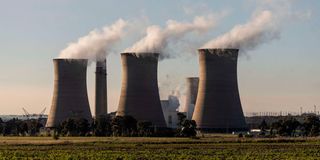
In this file photo taken on December 18, 2022, A general view of the Grootvlei Power Station, a coal-fired power plant operated by Eskom located in Grootvlei.
By January this year, Minerals Council members had a pipeline of 3,900MW of potential renewable energy projects worth more than $3.5 billion in process, substantially contributing, once operational, to bridging the country’s widening electricity supply deficit.
Solar power dependence
S. Africa’s biggest gold mine, Gold Fields’ South Deep, is already switching to solar power, saving $7.25 million in electricity costs annually, lowering its carbon footprint, and mitigating load-shedding disruptions, said the firm.
The solar plant being installed was initially planned to have a capacity of 40MW, but four months after the national energy regulator’s approval for the project, the S. African government increased the allowed embedded generation threshold to go up to 100MW.
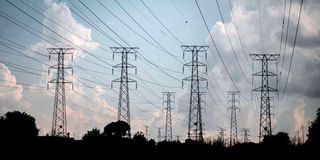
In this file photo taken on November 26, 2022, Electric poles are seen in Soweto. - South Africa's President Cyril Ramaphosa declared a national disaster on February 9, 2023, in a bid to fast-track efforts to tackle a record electricity shortage that has put the brakes on economic growth in Africa's most industrialised economy.
Gold Fields then increased the plant’s planned capacity to 50MW, with the potential to expand a further 10MW.
These steps by both large and smaller players, mainly in their own commercial interests, offer some ‘green shoots’ optimism for a hard-pressed sector, which has also been hit by the down-stream effects of power outages, such as the inability of national rail carrier Transnet to achieve barely half, 50 million tonnes, of its over 90-million-tonne coal export capacity, due to operational shortfalls, damage to rail infrastructure and power shortages.
But mining has other problems too, as pointed out last week by President Ramaphosa at an annual ‘mining indaba’ conference, where he spelt out the key sector’s major issues, power being at the top of the agenda, closely followed by the issue of illegal mining and the so-called ‘invasion of the Zama Zamas’.
Last week, President Cyril Ramaphosa promised that the illegal mining operations would be brought under control, and the threat posed by the largely lawless Zama Zamas to the communities they lived in or near, ended.
Mining, he said, had been the bedrock of African economies, specifically S Africa’s, “for millennia”, and “continues to play a pivotal role in development and industrialisation across the continent”.
Government action
Speaking to core players, local and international, on developments in S. Africa’s mining sector, Ramaphosa outlined steps required to set the industry back on track.
These urgent steps, which started with stabilising the highly unreliable national power supply, were vital for the recovery of both mining and the economy as a whole, Ramaphosa told delegates.

Supporters of the far-left Economic Freedom Fighter (EFF) party march in Johannesburg on February 28, 2020, during a protest against the embattled South African power utility Eskom. - South Africa's radical far-left opposition EFF activists staged a protest march in Johannesburg against frequent power outages that have played havoc in Africa's most industrialised company.
S Africa had an abundance of mineral resources, accounting for a significant proportion of world production and reserves, with an estimated worth of $2.5 trillion.
But the sector, said Ramaphosa, was performing at half of its potential, the shortfall due to the uncertain and frequently interrupted power supply, along with the inability to export to the full extent potentially possible, due mostly to inadequacies and unrepaired infrastructure used by national rail transporter Transnet, an early ‘victim’ of ‘state capture’ corruption.
Mining sector players said that coal exports, for example, were at slightly over half their potential, despite a huge increase in demand, especially from energy-starved European countries due to the war in Ukraine.
“In 2022 coal exports through the Richards Bay Coal Terminal (a specialist coal export facility on SA’s Indian Ocean coastline) dropped to about 50 million tonnes, the worst performance since 1993,” said Ramaphosa.
“It is estimated that infrastructure inefficiencies have resulted in a 15 per cent decline in mineral sales,” said Ramaphosa.
“In the global drive towards sustainability, the mining sector has a particularly important role to play, requiring it to be responsible, agile and innovative.
“For South Africa, mining continues to be an essential part of our economy, (being) an important contributor to job creation, accounting for close to half a million direct jobs and close to a million indirect jobs,” Ramaphosa told delegates at the Cape Town International Convention Centre.
“In addition to the energy crisis and problems with port and rail operations, the outlook for the year ahead has been dampened by concerns about safety and security, illegal mining and the pace of our structural reform programme.
“These are precisely the issues that the government is working to address.”
Ramaphosa listed four priorities of his administration: secure the electricity supply, accelerate economic reforms to promote new investment, tackle illegal mining and damage to infrastructure, and cut administrative red tape.
“We have a responsibility as government, industry, labour and communities to ensure that our mining industry is able to grow, to become more globally competitive and to be a pioneer in the global drive towards sustainable development,” Ramaphosa said.
Tomorrow: South Africa’s dead feel the heat of power crisis.





